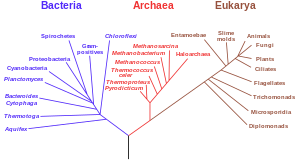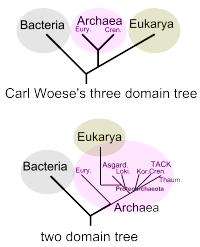|
Domain (biology) In biological taxonomy, a domain (/dəˈmeɪn/ or /doʊˈmeɪn/) (Latin: regio[1]), also dominion,[2] superkingdom, realm, or empire, is the highest taxonomic rank of all organisms taken together. It was introduced in the three-domain system of taxonomy devised by Carl Woese, Otto Kandler and Mark Wheelis in 1990.[1] According to the domain system, the tree of life consists of either three domains, Archaea, Bacteria, and Eukarya,[1] or two domains, Archaea and Bacteria, with Eukarya included in Archaea.[3][4] In the three-domain model, the first two are prokaryotes, single-celled microorganisms without a membrane-bound nucleus. All organisms that have a cell nucleus and other membrane-bound organelles are included in Eukarya and called eukaryotes. Non-cellular life, most notably the viruses, is not included in this system. Alternatives to the three-domain system include the earlier two-empire system (with the empires Prokaryota and Eukaryota), and the eocyte hypothesis (with two domains of Bacteria and Archaea, with Eukarya included as a branch of Archaea). TerminologyThe term domain was proposed by Carl Woese, Otto Kandler, and Mark Wheelis (1990) in a three-domain system. This term represents a synonym for the category of dominion (Lat. dominium), introduced by Moore in 1974.[2] Development of the domain systemCarl Linnaeus made the classification "domain" popular in the famous taxonomy system he created in the middle of the eighteenth century. This system was further improved by the studies of Charles Darwin later on but could not classify bacteria easily, as they have very few observable features to compare to the other domains.[5] Carl Woese made a revolutionary breakthrough when, in 1977, he compared the nucleotide sequences of the 16s ribosomal RNA and discovered that the rank "domain" contained three branches, not two as scientists had previously thought. Initially, due to their physical similarities, Archaea and Bacteria were classified together and called "archaebacteria". However, scientists now know that these two domains are hardly similar and are internally distinctly different.[6] Characteristics of the three domains   Each of these three domains contains unique ribosomal RNA. This forms the basis of the three-domain system. While the presence of a nuclear membrane differentiates the Eukarya from the Archaea and Bacteria, both of which lack a nuclear envelope, the Archaea and Bacteria are distinct from each other due to differences in the biochemistry of their cell membranes and RNA markers.[1] ArchaeaArchaea are prokaryotic cells, typically characterized by membrane lipids that are branched hydrocarbon chains attached to glycerol by ether linkages. The presence of these ether linkages in Archaea adds to their ability to withstand extreme temperatures and highly acidic conditions, but many archaea live in mild environments. Halophiles (organisms that thrive in highly salty environments) and hyperthermophiles (organisms that thrive in extremely hot environments) are examples of Archaea.[1] Archaea are relatively small. They range from 0.1 μm to 15 μm diameter and up to 200 μm long, about the size of bacteria and the mitochondria found in eukaryotic cells. Members of the genus Thermoplasma are the smallest Archaea.[1] BacteriaCyanobacteria and mycoplasmas are two examples of bacteria. Even though bacteria are prokaryotic cells like Archaea, their cell membranes are instead made of phospholipid bilayers, with none of the ether linkages that Archaea have. Internally, bacteria have different RNA structures in their ribosomes, hence they are grouped into a different category. In the two- and three-domain systems, this puts them into a separate domain. There is a great deal of diversity in the domain Bacteria. That diversity is further confounded by the exchange of genes between different bacterial lineages. The occurrence of duplicate genes between otherwise distantly-related bacteria makes it nearly impossible to distinguish bacterial species, count the bacterial species on the Earth, or organize them into a tree-like structure (unless the structure includes cross-connections between branches, making it a "network" instead of a "tree").[1] EukaryaMembers of the domain Eukarya – called eukaryotes – have membrane-bound organelles (including a nucleus containing genetic material) and are represented by five kingdoms: Plantae, Protozoa, Animalia, Chromista, and Fungi.[1] Exclusion of viruses and prionsThe three-domain system includes no form of non-cellular life. Stefan Luketa proposed a five-dominion system in 2012, adding Prionobiota (acellular and without nucleic acid) and Virusobiota (acellular but with nucleic acid) to the traditional three domains.[9] Alternative classifications
Alternative classifications of life include:
See also
References
External links |
|||||||||||||||||||||||||||||||||||||||